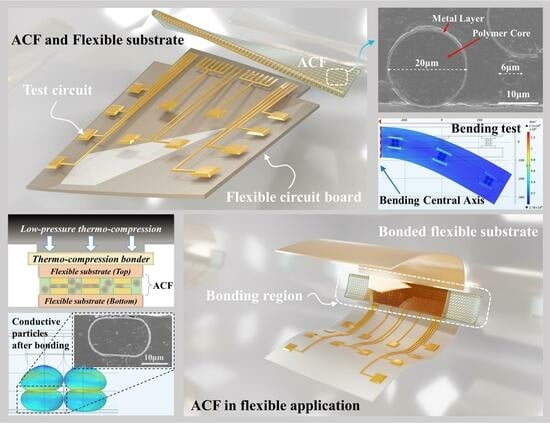Size Effects of Au/Ni-Coated Polymer Particles on the Electrical Performance of Anisotropic Conductive Adhesive Films under Flexible Mechanical Conditions
Abstract
:1. Introduction
2. Material and Methods
2.1. Materials
2.2. Bonding Process
2.3. Characterization
2.3.1. Scanning Electron Microscopy and Energy Dispersive X-ray Spectroscopy
2.3.2. Electrical Test
2.3.3. Bending Test
2.3.4. Modeling and Simulation
3. Results and Discussions
3.1. Morphological Characterization
3.2. ACF Bonding Results
3.3. Bending Test Results
3.4. Bending Simulation Results
3.5. The Failure Mechanism during Bending Process
4. Conclusions
Supplementary Materials
Author Contributions
Funding
Institutional Review Board Statement
Informed Consent Statement
Data Availability Statement
Acknowledgments
Conflicts of Interest
References
- Huang, Q.; Zhu, Y. Printing Conductive Nanomaterials for Flexible and Stretchable Electronics: A Review of Materials, Processes, and Applications. Adv. Mater. Technol. 2019, 4, 1800546. [Google Scholar] [CrossRef]
- Liu, K.; Ouyang, B.; Guo, X.; Guo, Y.; Liu, Y. Advances in Flexible Organic Field-Effect Transistors and Their Applications for Flexible Electronics. Npj Flex. Electron. 2022, 6, 1. [Google Scholar] [CrossRef]
- Gu, Y.; Huo, Y. Advanced Electronic Packaging Technology: From Hard to Soft. Materials 2023, 16, 2346. [Google Scholar] [CrossRef] [PubMed]
- Yoon, D.-J.; Lee, S.-H.; Paik, K.-W. Effects of Polyacrylonitrile Anchoring Polymer Layer Solder Anisotropic Conductive Films on the Solder Ball Movement for Fine-Pitch Flex-on-Flex (FOF) Assembly. IEEE Trans. Compon. Packag. Manuf. Technol. 2019, 9, 830–835. [Google Scholar] [CrossRef]
- Yu, D.; Yang, Y.-Q.; Chen, Z.; Tao, Y.; Liu, Y.-F. Recent Progress on Thin-Film Encapsulation Technologies for Organic Electronic Devices. Opt. Commun. 2016, 362, 43–49. [Google Scholar] [CrossRef]
- Yang, M.; Li, G.; Gu, Y.; Song, J.; Li, H.; Zhao, X.; Huo, Y. Liquid Metal-Based Flexible and Wearable Thermoelectric Cooling Structure and Cooling Performance Optimization. Sci. China Mater. 2023, 66, 4001–4011. [Google Scholar] [CrossRef]
- Cao, C.; Yang, M.; Liang, C.; Zhang, D.; Chen, X.; Zhao, X.; Lee, C.C.; Huo, Y. A Phase-Field Model of Electrochemical Migration for Silver-Based Conductive Adhesives. Electrochim. Acta 2023, 471, 143388. [Google Scholar] [CrossRef]
- Kang, Q.; Li, G.; Li, Z.; Tian, Y.; Wang, C. Surface Co-Hydrophilization via Ammonia Inorganic Strategy for Low-Temperature Cu/SiO2 Hybrid Bonding. J. Mater. Sci. Technol. 2023, 149, 161–166. [Google Scholar] [CrossRef]
- Lau, J.H. Recent Advances and New Trends in Flip Chip Technology. J. Electron. Packag. 2016, 138, 030802. [Google Scholar] [CrossRef]
- Malik, M.H.; Grosso, G.; Zangl, H.; Binder, A.; Roshanghias, A. Flip Chip Integration of Ultra-Thinned Dies in Low-Cost Flexible Printed Electronics; the Effects of Die Thickness, Encapsulation and Conductive Adhesives. Microelectron. Reliab. 2021, 123, 114204. [Google Scholar] [CrossRef]
- Wang, T.; Gu, S.; Fang, Y.; Zhang, D.; Xie, X.; Qu, Z.; Wang, Y.; Zhao, X.; Wu, J.; Lee, C.C.; et al. Plasma-Induced Growth Mechanism of Surface-State Silver Oxide in Nanoscale for Low-Temperature Bonding Technology. Mater. Charact. 2023, 199, 112830. [Google Scholar] [CrossRef]
- Song, J.; Zhang, D.; Chen, X.; Hu, S.; Zhao, X.; Lee, C.C.; Huo, Y. Ultrasonic-Enhanced Silver-indium Transient Liquid Phase Bonding in Advancing Rapid and Low-Temperature Packaging. Mater. Charact. 2024, 210, 113793. [Google Scholar] [CrossRef]
- Lau, J.H. Recent Advances and Trends in Advanced Packaging. IEEE Trans. Compon. Packag. Manuf. Technol. 2022, 12, 228–252. [Google Scholar] [CrossRef]
- Hwang, H.; Kong, M.; Kim, K.; Park, D.; Lee, S.; Park, S.; Song, H.-J.; Jeong, U. Stretchable Anisotropic Conductive Film (S-ACF) for Electrical Interfacing in High-Resolution Stretchable Circuits. Sci. Adv. 2021, 7, eabh0171. [Google Scholar] [CrossRef] [PubMed]
- Yoon, D.-J.; Malik, M.-H.; Yan, P.; Paik, K.-W.; Roshanghias, A. ACF Bonding Technology for Paper- and PET-Based Disposable Flexible Hybrid Electronics. J. Mater. Sci. Mater. Electron. 2021, 32, 2283–2292. [Google Scholar] [CrossRef]
- Um, J.G.; Jeong, D.Y.; Jung, Y.; Moon, J.K.; Jung, Y.H.; Kim, S.; Kim, S.H.; Lee, J.S.; Jang, J. Active-Matrix GaN µ-LED Display Using Oxide Thin-Film Transistor Backplane and Flip Chip LED Bonding. Adv. Electron. Mater. 2019, 5, 1800617. [Google Scholar] [CrossRef]
- Chang, L.-P.; Wang, J.-J.; Hung, T.-H.; Chen, K.-N.; Ouyang, F.-Y. Direct Metal Bonding Using Nanotwinned Ag Films with (1 1 1) Surface Orientation under Air Atmosphere for Heterogeneous Integration. Appl. Surf. Sci. 2022, 576, 151845. [Google Scholar] [CrossRef]
- Lee, S.-H.; Paik, K.-W. A Study on the Nanofiber-Sheet Anisotropic Conductive Films (NS-ACFs) for Ultra-Fine-Pitch Interconnection Applications. J. Electron. Mater. 2017, 46, 167–174. [Google Scholar] [CrossRef]
- Huo, Y.; Wu, J.; Lee, C.C. Solid Solution Softening and Enhanced Ductility in Concentrated FCC Silver Solid Solution Alloys. Mater. Sci. Eng. A 2018, 729, 208–218. [Google Scholar] [CrossRef]
- Zhang, S.; Qi, X.; Yang, M.; Cao, Y.; Lin, T.; He, P.; Paik, K.-W. A Study on the Resistivity and Mechanical Properties of Modified Nano-Ag Coated Cu Particles in Electrically Conductive Adhesives. J. Mater. Sci. Mater. Electron. 2019, 30, 9171–9183. [Google Scholar] [CrossRef]
- Zhao, S.; Zheng, B.; Zhang, D.; Xie, X.; Qu, Z.; Wang, Y.; Zhao, X.; Wu, J.; Lee, C.C.; Huo, Y. Atomistic Insights into Silver-Indium Solid Solution Softening Mechanism for Microelectronics Packaging. J. Mater. Res. Technol. 2023, 24, 6065–6075. [Google Scholar] [CrossRef]
- Zhang, S.; Yang, M.; Wu, Y.; Du, J.; Lin, T.; He, P.; Huang, M.; Paik, K.-W. A Study on the Optimization of Anisotropic Conductive Films for Sn-3Ag-0.5Cu-Based Flex-on-Board Application at a 250 °C Bonding Temperature. IEEE Trans. Compon. Packag. Manuf. Technol. 2018, 8, 383–391. [Google Scholar] [CrossRef]
- Nghiem, G.M.; Aasmundtveit, K.E.; Kristiansen, H.; Bazilchuk, M. Anisotropic Conductive Film (ACF) Bonding: Effect of Interfaces on Contact Resistance. In Proceedings of the 2018 7th Electronic System-Integration Technology Conference (ESTC), Dresden, Germany, 18–21 September 2018; pp. 1–5. [Google Scholar]
- Kim, S.-C.; Kim, Y.-H. Review Paper: Flip Chip Bonding with Anisotropic Conductive Film (ACF) and Nonconductive Adhesive (NCA). Curr. Appl. Phys. 2013, 13, S14–S25. [Google Scholar] [CrossRef]
- Aradhana, R.; Mohanty, S.; Nayak, S.K. A Review on Epoxy-Based Electrically Conductive Adhesives. Int. J. Adhes. Adhes. 2020, 99, 102596. [Google Scholar] [CrossRef]
- Pan, Y.; Peng, X.; Zhu, P.; Sun, R.; Paik, K.-W. Interface Adhesion Effect of Anchoring Polymer Layer Anisotropic Conductive Films on the Bending Reliability for Ultra-Fine Pitch Wearable Chip-on-Flex Packages. In Proceedings of the 2022 23rd International Conference on Electronic Packaging Technology (ICEPT), Dalian, China, 10–13 August 2022; pp. 1–3. [Google Scholar]
- Jeong, Y.H.; Jung, S.-W.; Jin, S.; Kim, K.-S.; Yun, W.-S. Optimization and Reliability Evaluation of COG Bonding Process. J. Mech. Sci. Technol. 2016, 30, 1305–1313. [Google Scholar] [CrossRef]
- Lin, C.-M.; Chen, D.-C.; Liu, Y.-C. Investigation on Fracture and Conductivity of Flex-on-Film Flexible Bonding Using Anisotropic Conductive Film Considering Repeated Bending. Microsyst. Technol. 2019, 25, 3017–3026. [Google Scholar] [CrossRef]
- Buga, C.S.; Viana, J.C. A Review on Materials and Technologies for Organic Large-Area Electronics. Adv. Mater. Technol. 2021, 6, 2001016. [Google Scholar] [CrossRef]
- Ding, S.; Ying, J.; Chen, F.; Fu, L.; Lv, Y.; Zhao, S.; Ji, G. Highly Stretchable Conductors Comprising Composites of Silver Nanowires and Silver Flakes. J. Nanoparticle Res. 2021, 23, 111. [Google Scholar] [CrossRef]
- Lin, C.-M.; Lin, T.-C.; Liu, Y.-C. Electric Conduction Failure of ACF Packages Based on Pad Array Aspect Ratio Consideration. Microsyst. Technol. 2016, 22, 2883–2891. [Google Scholar] [CrossRef]
- Trupp, F.J.; Cibils, R.M.; Goyanes, S.N. Conductive Particles in Anisotropic Conductive Films; Crimson Publishers: New York, NY, USA, 2022. [Google Scholar] [CrossRef]
- Lee, S.-H.; Suk, K.-L.; Lee, K.; Paik, K.-W. Study on Fine Pitch Flex-on-Flex Assembly Using Nanofiber/Solder Anisotropic Conductive Film and Ultrasonic Bonding Method. IEEE Trans. Compon. Packag. Manuf. Technol. 2012, 2, 2108–2114. [Google Scholar] [CrossRef]
- Yim, M.J.; Hwang, J.; Paik, K.W. Anisotropic Conductive Films (ACFs) for Ultra-Fine Pitch Chip-on-Glass (COG) Applications. In Proceedings of the International Symposium on Advanced Packaging Materials: Processes, Properties and Interfaces, Irvine, CA, USA, 16–18 March 2005; pp. 181–186. [Google Scholar]
- Harris, K.D.; Elias, A.L.; Chung, H.-J. Flexible Electronics under Strain: A Review of Mechanical Characterization and Durability Enhancement Strategies. J. Mater. Sci. 2016, 51, 2771–2805. [Google Scholar] [CrossRef]
- Manson, J.; Rw, H. Fatigue failure in polymers. CRC Crit. Rev. Macromol. Sci. 1973, 1, 433–500. [Google Scholar]
- Lin, Y.C.; Chen, X.-M.; Zhang, J. Uniaxial Ratchetting Behavior of Anisotropic Conductive Adhesive Film under Cyclic Tension. Polym. Test. 2011, 30, 8–15. [Google Scholar] [CrossRef]
- Lee, J.-S.; Kim, J.-H.; Paik, K.-W. A Study on the Fine Pitch Flex-on-Flex (FOF) Assembly Using Flux Added Nanofiber Solder Anisotropic Conductive Films (ACFs) and Thermo-Compression Bonding Method. In Proceedings of the 2017 IEEE 67th Electronic Components and Technology Conference (ECTC), Orlando, FL, USA, 30 May–2 June 2017; pp. 2168–2174. [Google Scholar]
- Kim, S.-C.; Kim, Y.-H. Low Temperature Chip on Film Bonding Technology for 20 Μm Pitch Applications. J. Mater. Sci. Mater. Electron. 2016, 27, 3658–3667. [Google Scholar] [CrossRef]
- Zhang, S.; Park, J.; Park, G.; Song, H.; Kim, J.; Paik, K.-W.; He, P. A Study on Transmission Properties of AuNi Coated Polymer Ball Joint and Sn58Bi Solder Joint for Flex-on-Board Interconnection. J. Adv. Join. Process. 2022, 5, 100099. [Google Scholar] [CrossRef]
- Zhang, S.; Paik, K.-W. A Study on the Failure Mechanism and Enhanced Reliability of Sn58Bi Solder Anisotropic Conductive Film Joints in a Pressure Cooker Test Due to Polymer Viscoelastic Properties and Hydroswelling. IEEE Trans. Compon. Packag. Manuf. Technol. 2016, 6, 216–223. [Google Scholar] [CrossRef]
- Kim, J.-H.; Lee, T.-I.; Shin, J.-W.; Kim, T.-S.; Paik, K.-W. Bending Properties of Anisotropic Conductive Films Assembled Chip-in-Flex Packages for Wearable Electronics Applications. IEEE Trans. Compon. Packag. Manuf. Technol. 2016, 6, 208–215. [Google Scholar] [CrossRef]
- Merilampi, S.; Laine-Ma, T.; Ruuskanen, P. The Characterization of Electrically Conductive Silver Ink Patterns on Flexible Substrates. Microelectron. Reliab. 2009, 49, 782–790. [Google Scholar] [CrossRef]
- Amor-Martin, A.; Garcia-Castillo, L.E. Adaptive Semi-Structured Mesh Refinement Techniques for the Finite Element Method. Appl. Sci. 2021, 11, 3683. [Google Scholar] [CrossRef]
- Pan, Y.; Song, L.; Zhang, S.; Cai, X.; Paik, K.-W. Effects of Polymer Conductive Particle Contents on the Electrical Performance and Reliability of 50-μm Pitch Flex-on-Flex Assemblies Using Anisotropic Conductive Films. IEEE Trans. Compon. Packag. Manuf. Technol. 2017, 7, 1759–1764. [Google Scholar] [CrossRef]
- Lin, C.-M.; Chu, C.-Y. Experiments of Failure and Damage in ITO-Coated PC/FPC with ACF Bonding Due to Bending Fatigue. Key Eng. Mater. 2024, 978, 67–71. [Google Scholar] [CrossRef]
- Kim, T.-W.; Lee, T.-I.; Pan, Y.; Kim, W.; Zhang, S.; Kim, T.-S.; Paik, K.-W. Effect of Nanofiber Orientation on Nanofiber Solder Anisotropic Conductive Films Joint Properties and Bending Reliability of Flex-on-Flex Assembly. IEEE Trans. Compon. Packag. Manuf. Technol. 2016, 6, 1317–1329. [Google Scholar] [CrossRef]
- Kim, J.-H.; Yoon, D.-J.; Paik, K.-W. Bending Properties of Fine Pitch Flexible CIF (Chip-in-Flex) Packages Using APL (Anchoring Polymer Later) ACFs (Anisotropic Conductive Films). In Proceedings of the 2019 IEEE 69th Electronic Components and Technology Conference (ECTC), Las Vegas, NV, USA, 28–31 May 2019; pp. 2272–2277. [Google Scholar]
- Pan, Y.; Oh, S.-J.; Kim, J.-H.; Kim, T.-S.; Paik, K.-W. A Study on the Dynamic Bending Property of Chip-on-Flex Assembly Using Anchoring Polymer Layer Anisotropic Conductive Films. IEEE Trans. Compon. Packag. Manuf. Technol. 2020, 10, 941–948. [Google Scholar] [CrossRef]

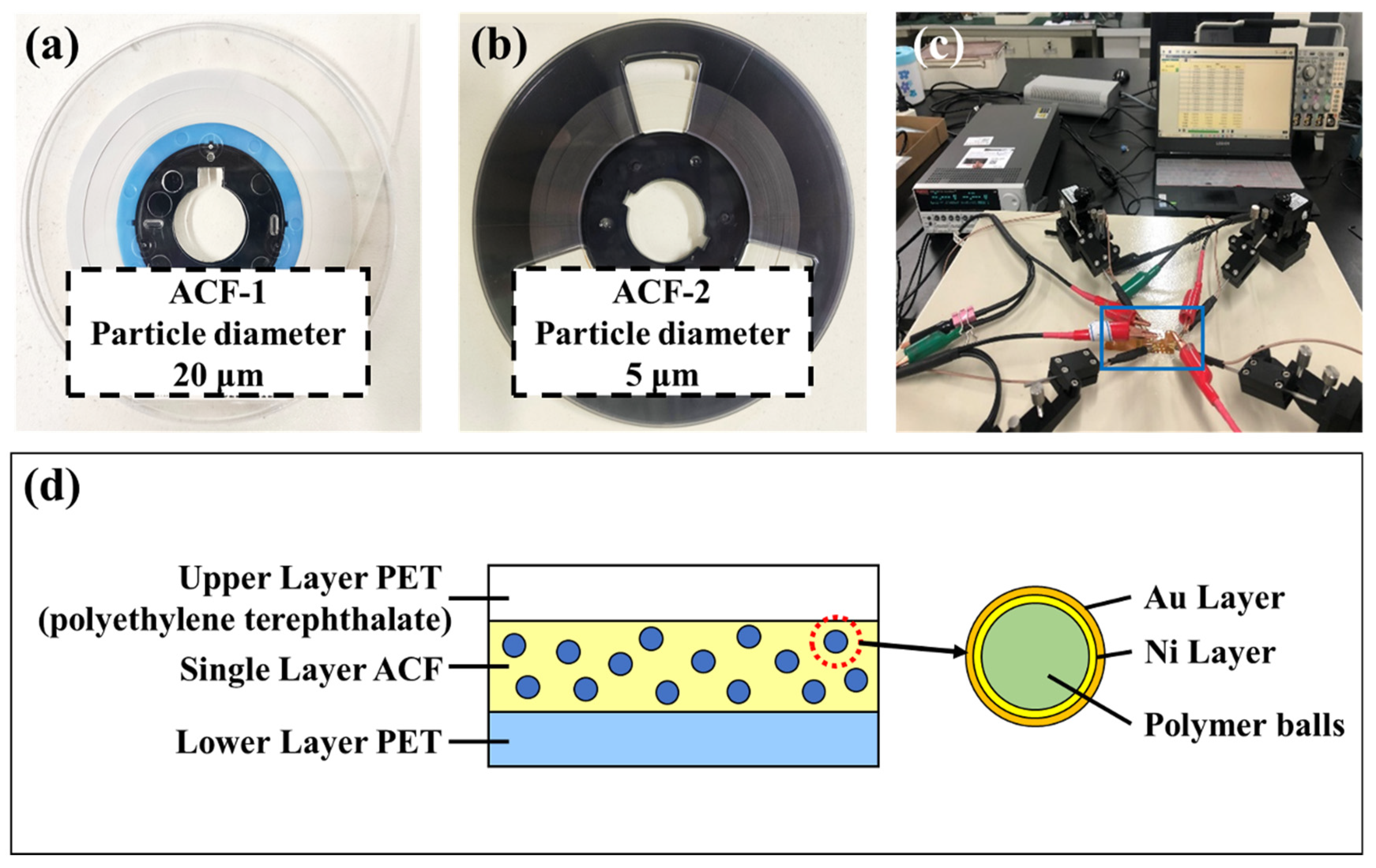
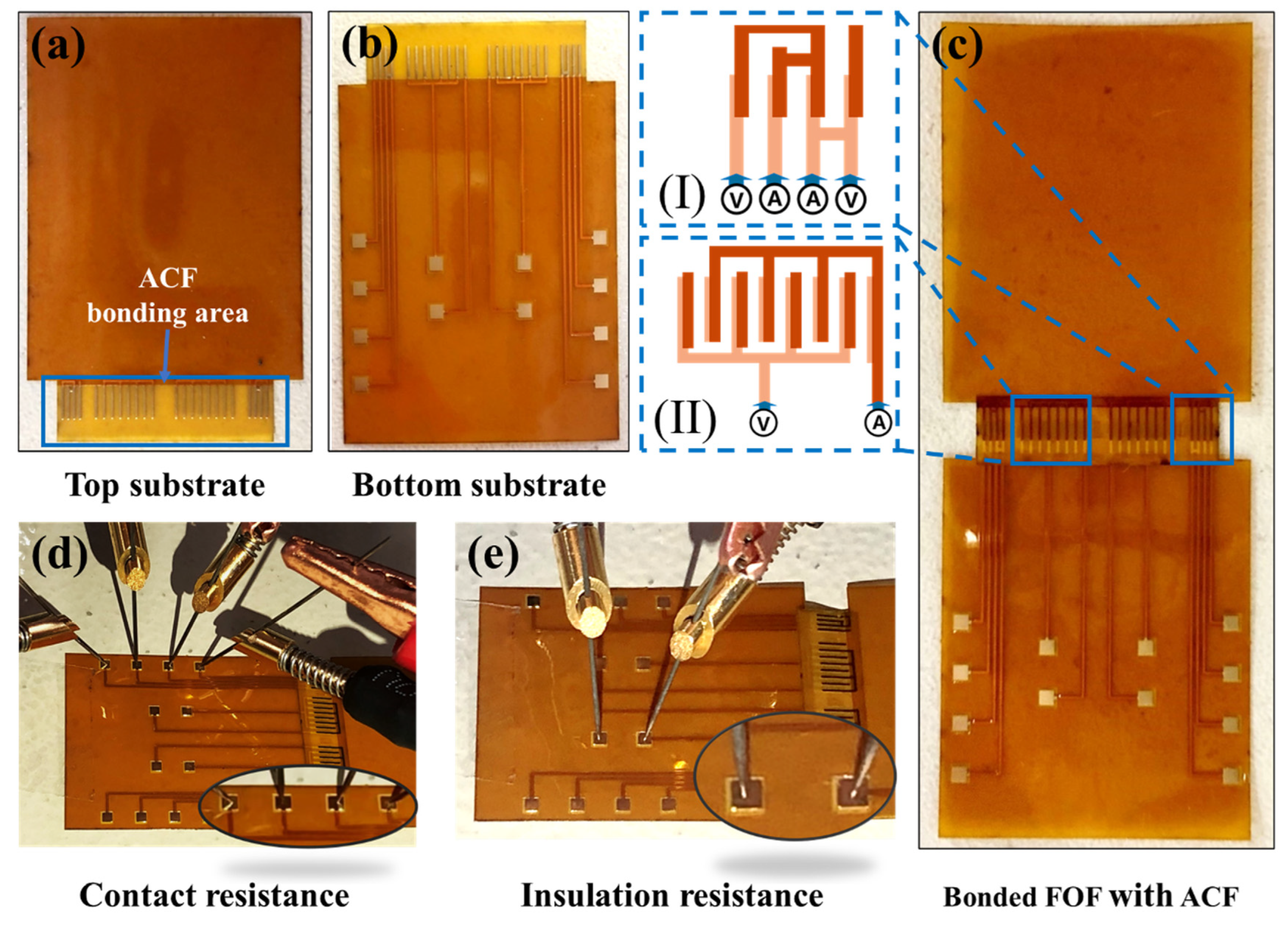

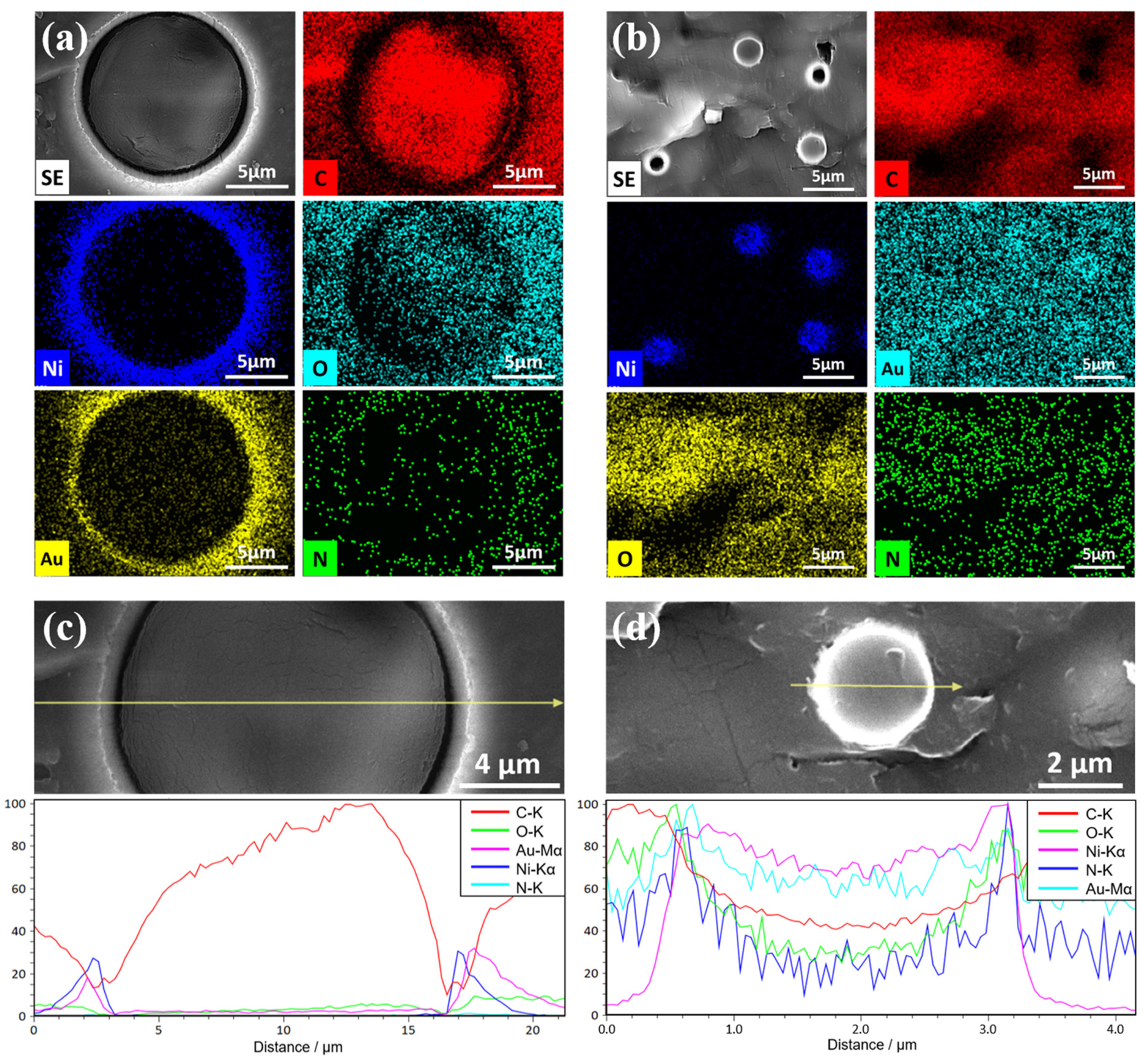
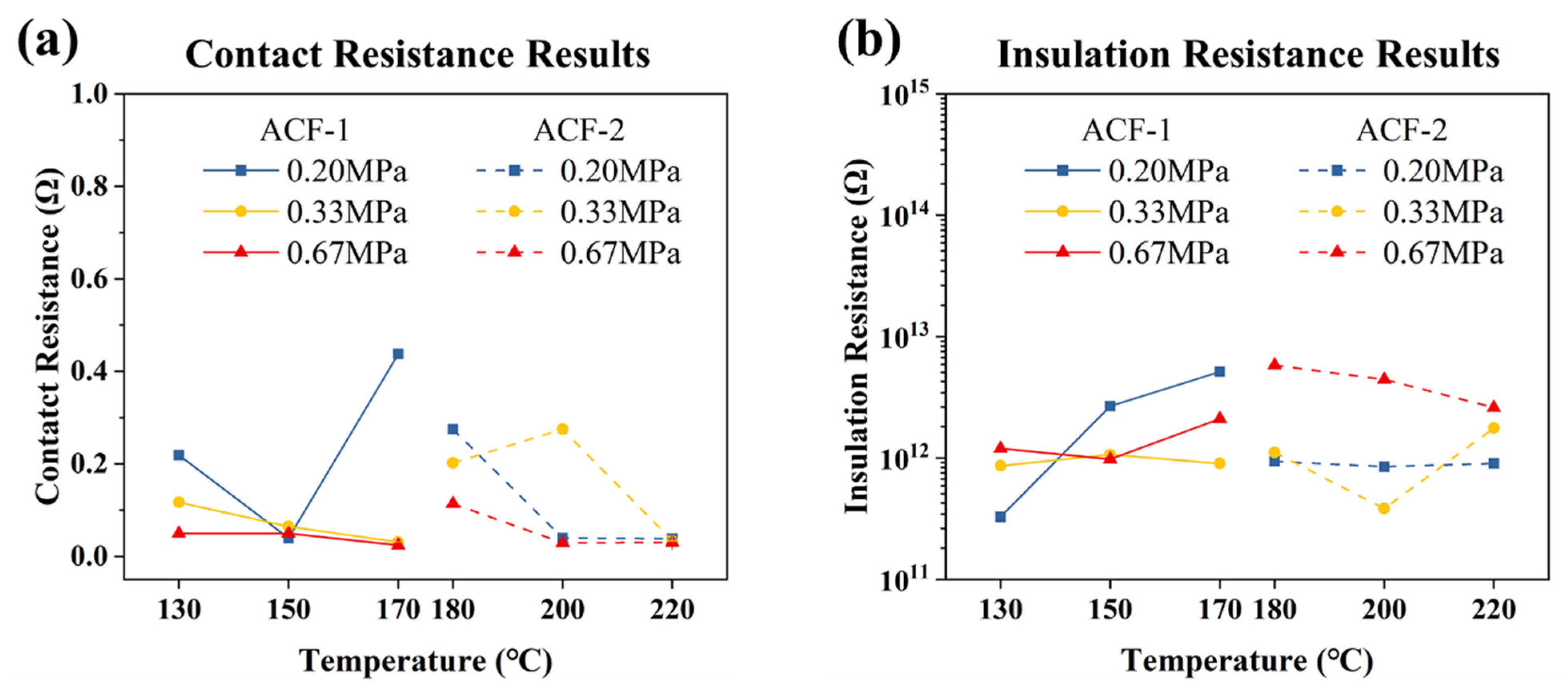

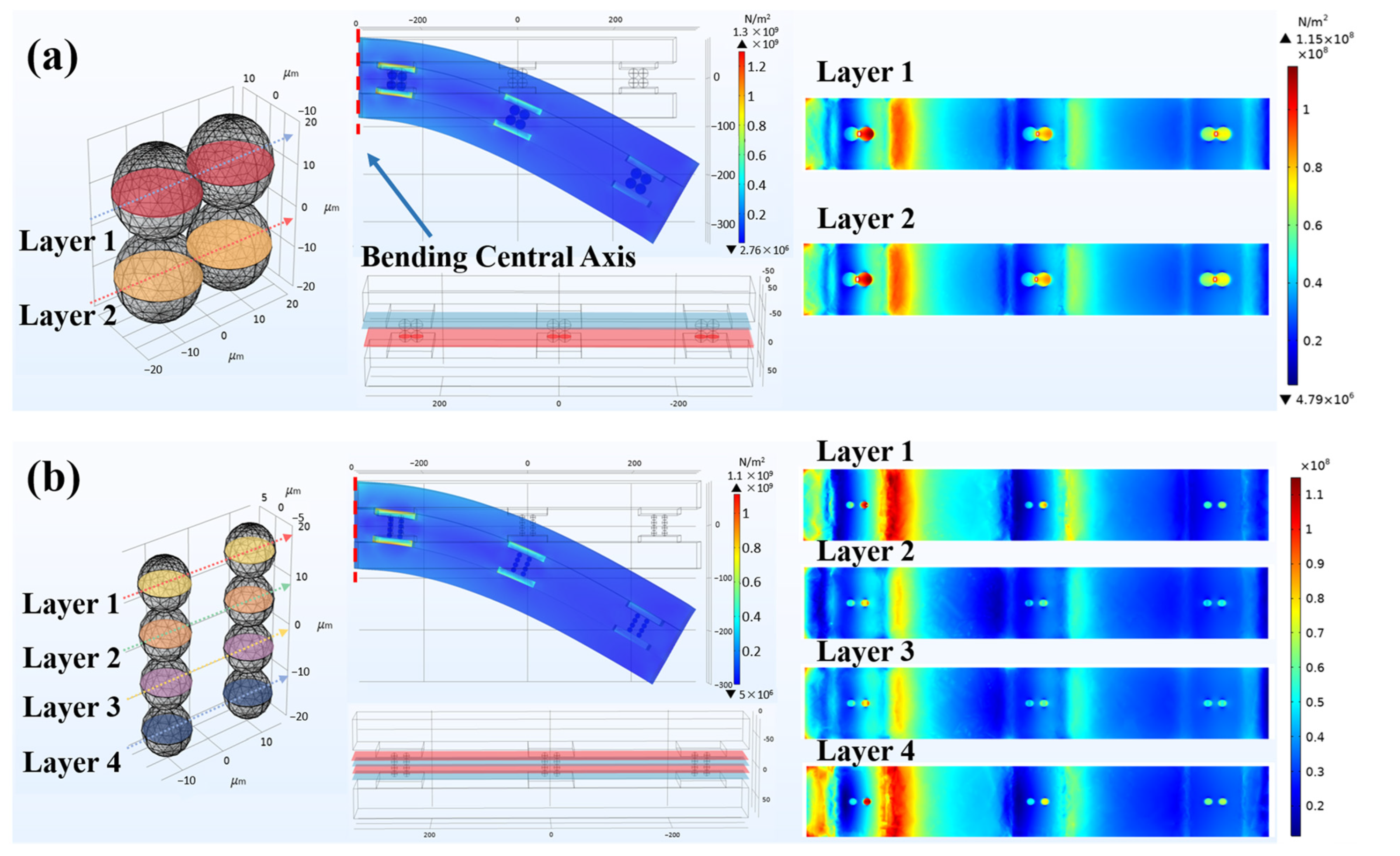

| ACF Type | Temporary Bonding | Final Bonding | ||||
|---|---|---|---|---|---|---|
| Pressure (MPa) | Temperature (°C) | Time (s) | Pressure (MPa) | Temperature (°C) | Time (s) | |
| ACF-1 | 1 | 80 | 2 | 0.67 | 150 | 15 |
| ACF-2 | 1 | 80 | 2 | 0.67 | 200 | 10 |
| ACF Type | Temporary Bonding | Final Bonding | ||||
|---|---|---|---|---|---|---|
| Pressure (MPa) | Temperature (°C) | Time (s) | Pressure (MPa) | Temperature (°C) | Time (s) | |
| ACF-1 | Same as the standard bonding parameters | 0.20 | 130, 150, 170 | 15 | ||
| ACF-1 | 0.33 | 130, 150, 170 | 15 | |||
| ACF-1 | 0.67 | 130, 150, 170 | 15 | |||
| ACF-2 | Same as the standard bonding parameters | 0.20 | 180, 200, 220 | 10 | ||
| ACF-2 | 0.33 | 180, 200, 220 | 10 | |||
| ACF-2 | 0.67 | 180, 200, 220 | 10 | |||
| Part | Material | Young’s Modulus (GPa) | Density (kg·m−3) | Poisson’s Ratio | Thickness (μm) |
|---|---|---|---|---|---|
| * Flex. Sub. | PI (Polyimide) | 2.5 | 1500 | 0.34 | 50 |
| Electrode | Cu | 110.0 | 8960 | 0.35 | 1.2 |
| Resin matrix | Epoxy resin | 2.0 | 2000 | 0.4 | 40 |
| Conductive particles | PP (Polypropylene) | 8.9 | 900 | 0.4203 | 20 (diameter) 10 (diameter) |
Disclaimer/Publisher’s Note: The statements, opinions and data contained in all publications are solely those of the individual author(s) and contributor(s) and not of MDPI and/or the editor(s). MDPI and/or the editor(s) disclaim responsibility for any injury to people or property resulting from any ideas, methods, instructions or products referred to in the content. |
© 2024 by the authors. Licensee MDPI, Basel, Switzerland. This article is an open access article distributed under the terms and conditions of the Creative Commons Attribution (CC BY) license (https://creativecommons.org/licenses/by/4.0/).
Share and Cite
Fang, Y.; Wang, T.; Gu, Y.; Yang, M.; Li, H.; Shi, S.; Zhao, X.; Huo, Y. Size Effects of Au/Ni-Coated Polymer Particles on the Electrical Performance of Anisotropic Conductive Adhesive Films under Flexible Mechanical Conditions. Materials 2024, 17, 1658. https://doi.org/10.3390/ma17071658
Fang Y, Wang T, Gu Y, Yang M, Li H, Shi S, Zhao X, Huo Y. Size Effects of Au/Ni-Coated Polymer Particles on the Electrical Performance of Anisotropic Conductive Adhesive Films under Flexible Mechanical Conditions. Materials. 2024; 17(7):1658. https://doi.org/10.3390/ma17071658
Chicago/Turabian StyleFang, Yexing, Taiyu Wang, Yue Gu, Mingkun Yang, Hong Li, Sujun Shi, Xiuchen Zhao, and Yongjun Huo. 2024. "Size Effects of Au/Ni-Coated Polymer Particles on the Electrical Performance of Anisotropic Conductive Adhesive Films under Flexible Mechanical Conditions" Materials 17, no. 7: 1658. https://doi.org/10.3390/ma17071658
APA StyleFang, Y., Wang, T., Gu, Y., Yang, M., Li, H., Shi, S., Zhao, X., & Huo, Y. (2024). Size Effects of Au/Ni-Coated Polymer Particles on the Electrical Performance of Anisotropic Conductive Adhesive Films under Flexible Mechanical Conditions. Materials, 17(7), 1658. https://doi.org/10.3390/ma17071658







